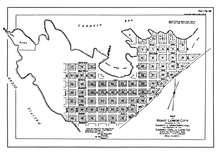Carmelito, California
Carmelito was a planned settlement, initially called Point Lobos City, on Point Lobos in Monterey County, California[1] It was located just north of Carmel Highlands and about 3 miles (4.8 km) south of Carmel on Highway 1. Located on the former Rancho San Jose y Sur Chiquito, the Carmelo Land and Coal Company planned the subdivision in 1890 when their coal mine on nearby Malpaso Creek proved to be unprofitable. They subdivided the land into 1,000 parcels and began selling lots for $25 to $50.[2][3][4] The lack of a bridge across the Carmel River and two national economic recessions during the 1890s combined to severely restrict sales.[5][6] Only a few small cabins were built.[7]
Carmelito | |
|---|---|
Planned settlement | |
 Carmelito Location in California | |
| Coordinates: 36°30′57.5″N 121°56′13″W | |
| Country | United States |
| State | California |
| County | Monterey County |
| Elevation | 45 ft (7 m) |
History

Alexander M. Allan, a successful race track architect and real estate developer from Illinois, purchased 640 acres (260 ha) of Point Lobos from the Carmelo Land and Coal Company in 1898. Allan and his wife Satie appreciated the natural beauty of the point and were concerned about the growing number of visitors who wanted to see the rare Monterey Cypress trees and scenic coastline. They put up toll gates, prohibited camping, and charged visitors 50 cents a vehicle (about $10 today) to enter the point. Allan bought the lots that had been subdivided and later got the subdivisions removed from the county record. Eunice Riley, Alexander's daughter, repurchased the last subdivided lots in the 1950s.[6][8][9][5]
Conversion to reserve
By the mid-1920s, the Save the Redwoods Leaguee was actively involved in an effort to preserve the Monterey Cypress. They hired the internationally known landscape architect, Frederick Law Olmsted, to research Point Lobos and report on the areas most noteworthy of preservation. Olmsted's report described Point Lobos as "the most outstanding example on the coast of California of picturesque rock and surf scenery in combination with unique vegetation, including typical Monterey Cypress."[10]
In 1933, three years after Alexander Allan's death, the State of California bought 348 acres (141 ha) from the Allan family for $631,000 and established the Point Lobos State Natural Reserve. The Allan family donated to the state an additional 15 acres (6.1 ha) of cypress-covered headlands at the western tip of the point as a memorial grove to Alexander and Satie Allan.[6][5][1]
References
- Durham, David L. (1998). California's Geographic Names: A Gazetteer of Historic and Modern Names of the State. Clovis, Calif.: Word Dancer Press. p. 881. ISBN 1-884995-14-4.
- Walton, John (2003). Storied Land: Community and Memory in Monterey. Berkeley, Calif.: University of California Press. ISBN 978-0520227231. Retrieved 7 May 2018.
- "The Allan Memorial Grove at Point Lobos State Reserve" (PDF). California State Parks. 2004. Retrieved 7 May 2018.
- Aubrey Drury, 1954, Point Lobos Reserve, California State Park, Department of Natural Resources, Sacramento pages=78-85
- "Point Lobos History". www.pt-lobos.com. Retrieved 7 May 2018.
- The Whaler's Cabin and The Whaling Station Museum (PDF), Point Lobos Foundation, 2017
- Hudson, Monica; Wood, Suzanne (2004). Point Lobos. Arcadia Publishing. ISBN 9781439630815.
- "History of Point Lobos". pointlobos.org. Point Lobos Foundation. Archived from the original on August 31, 2014. Retrieved 7 May 2018.
- Wiley, Marlene. "Point Lobos State Reserve". www.mnn.net. Retrieved 7 May 2018.
- "Map of Point Lobos Proposed California State Park, a part of Rancho San José y Sur Chiquito in Monterey County, Cal. - Price Estimate: $150 - $250". www.pbagalleries.com. Retrieved 8 May 2018.

